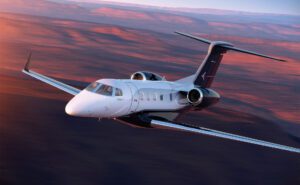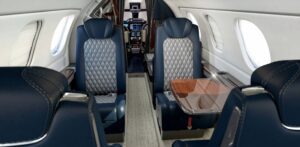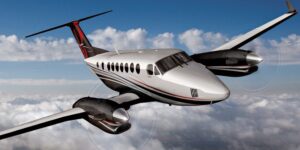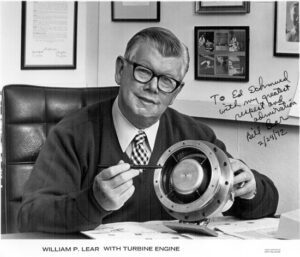Ebace 2023
 EBACE stands for the European Business Aviation Convention & Exhibition. It is an annual event held in Geneva, Switzerland that serves as a meeting place for leaders in the business aviation industry in Europe and beyond. The event provides a forum for manufacturers, suppliers, and service providers to showcase their products and services, network with industry peers, and discuss the latest trends and developments in the field of business aviation. EBACE features exhibits of aircraft, avionics, engines, and other related products and services. In addition, the event includes educational sessions, keynote speeches, and other presentations focused on business aviation topics such as safety, sustainability, and regulatory issues. EBACE is jointly hosted by the National Business Aviation Association (NBAA) and the European Business Aviation Association (EBAA). The event typically attracts thousands of attendees from around the world and is considered one of the premier events in the business aviation industry.
EBACE stands for the European Business Aviation Convention & Exhibition. It is an annual event held in Geneva, Switzerland that serves as a meeting place for leaders in the business aviation industry in Europe and beyond. The event provides a forum for manufacturers, suppliers, and service providers to showcase their products and services, network with industry peers, and discuss the latest trends and developments in the field of business aviation. EBACE features exhibits of aircraft, avionics, engines, and other related products and services. In addition, the event includes educational sessions, keynote speeches, and other presentations focused on business aviation topics such as safety, sustainability, and regulatory issues. EBACE is jointly hosted by the National Business Aviation Association (NBAA) and the European Business Aviation Association (EBAA). The event typically attracts thousands of attendees from around the world and is considered one of the premier events in the business aviation industry.
The 2023 European Business Aviation Convention & Exhibition (EBACE2023) is taking off at the magnificent Palexpo in Geneva, Switzerland, and the Geneva International Airport from Tuesday 23 May through Thursday 25 May 2023.
Sustainable Aviation Fuel at Ebace 2023
EBACE 2023 will commence with a keynote address by Toto Wolff, the team principal, CEO, and co-owner of the Mercedes-AMG Petronas F1 team, and Susie Wolff, the managing director of the F1 Academy, as announced by show organizers NBAA and EBAA. The duo was selected for their sustainable efforts both on and off the race track. The F1 team aims to achieve net-zero emissions by 2030, and it was the first global sports team to invest in sustainable aviation fuel. NBAA president and CEO Ed Bolen said, “Toto and Susie Wolff are pioneers who lead in various domains and are instrumental in creating a more diverse, equitable, and sustainable future for motorsport and other sectors. We are delighted to have them join us at EBACE 2023, and we look forward to hearing their perspectives on these and other issues of mutual significance to racing and aviation.” The Wolffs’ keynote session will begin the show’s week-long events, which will include a two-day Sustainability Summit that highlights the business aviation sector’s efforts to achieve the net-zero emissions goals set out in the Business Aviation Commitment on Climate Change, which was introduced in 2009. This summit will feature leaders in next-generation propulsion systems, advanced air mobility, carbon reduction advances, and other sustainability initiatives.
Ebace Innovative Exhibitions
EBACE 2023, a forward-thinking, cutting-edge, and innovative exhibition, will showcase impactful technologies across various categories, ranging from high-tech small aircraft to ultra-modern intercontinental jets, advanced air mobility, and eVTOL aircraft. With over 400 top aircraft manufacturers presenting state-of-the-art avionics, visitors can explore the latest offerings and make their businesses more rewarding and sustainable. More than 50 aircraft will be on display at the Geneva International Airport for airplane enthusiasts to climb on board, while the Innovation Pavilion will showcase current investment projects shaping product evolutions from disruptive companies.
The extensive exhibition at EBACE is complemented by a busy supporting event schedule. Over 15 insightful education sessions and an opening keynote will highlight the latest aviation trends, providing participating businesses with a competitive advantage in the market. EBACE 2023 will also cater to job seekers with Careers in Business Aviation Day, guiding future aviators into the world of employment in aerospace, technology, engineering, customer service, or entrepreneurship.
Ebace Accommodations
Demand for EBACE 2023 is already high, and accommodation options near Palexpo will sell out quickly. For EBACE2023, special discounted hotel rates with exclusive benefits for EBACE attendees have been negotiated and are seamlessly available online through their exclusive housing company, bnetwork.
For More Information
Please visit the EBACE 2023 Website HERE for all information pertaining to the event. That’s it for this week, so remember to Be Social, Fly Private!

 Verstappen – Perez – Verstappen – Perez, Red Bull racing’s best drivers have dominated Formula One Racing this year leading up to this weekend’s Miami Grand Prix. Red Bull Racing is Red hot and really has its “wings” coming into the race this weekend at Hard Rock Stadium. I don’t know if the drama with his longtime performance coach, Angela Cullen, has derailed Lewis Hamilton and his Mercedes Benz F1 racing team, but he does seem a bit off the pudding. I read all the social media “it’s not you, it’s me” breakup conversation, but I feel there is way more to that story so I kind of don’t see him rattling the cages of the drivers and teams above him in the F1 standings, at least not this weekend. Sergio Perez is driving very aggressively lately as a man with a mission to win it all, and its been all Max and Checo this year in Formula One.
Verstappen – Perez – Verstappen – Perez, Red Bull racing’s best drivers have dominated Formula One Racing this year leading up to this weekend’s Miami Grand Prix. Red Bull Racing is Red hot and really has its “wings” coming into the race this weekend at Hard Rock Stadium. I don’t know if the drama with his longtime performance coach, Angela Cullen, has derailed Lewis Hamilton and his Mercedes Benz F1 racing team, but he does seem a bit off the pudding. I read all the social media “it’s not you, it’s me” breakup conversation, but I feel there is way more to that story so I kind of don’t see him rattling the cages of the drivers and teams above him in the F1 standings, at least not this weekend. Sergio Perez is driving very aggressively lately as a man with a mission to win it all, and its been all Max and Checo this year in Formula One. 
 Embraer is a Brazilian aerospace company that produces commercial, military, and executive aircraft. Its private jet division, Embraer Executive Jets, focuses exclusively on the production of business jets for the private and corporate aviation market. Embraer Executive Jets offers a range of private jet models to suit the needs of various customers. These include the entry-level Phenom 100, the light Phenom 300, the midsize Praetor 500 and 600, and the large Legacy 650E. The Phenom 100 and Phenom 300 are popular choices for first-time private jet buyers or those looking for a cost-effective option. The Praetor 500 and 600 offer a balance between size, range, and speed, making them ideal for longer flights or those requiring more space. The Legacy 650E is Embraer’s largest and most luxurious private jet, capable of seating up to 14 passengers and traveling up to 3,900 nautical miles. In addition to offering a range of private jet models, Embraer Executive Jets provides a suite of services to support its customers. These include aircraft management, maintenance, and pilot training. Embraer’s customer support team is available 24/7 to assist with any issues that may arise.
Embraer is a Brazilian aerospace company that produces commercial, military, and executive aircraft. Its private jet division, Embraer Executive Jets, focuses exclusively on the production of business jets for the private and corporate aviation market. Embraer Executive Jets offers a range of private jet models to suit the needs of various customers. These include the entry-level Phenom 100, the light Phenom 300, the midsize Praetor 500 and 600, and the large Legacy 650E. The Phenom 100 and Phenom 300 are popular choices for first-time private jet buyers or those looking for a cost-effective option. The Praetor 500 and 600 offer a balance between size, range, and speed, making them ideal for longer flights or those requiring more space. The Legacy 650E is Embraer’s largest and most luxurious private jet, capable of seating up to 14 passengers and traveling up to 3,900 nautical miles. In addition to offering a range of private jet models, Embraer Executive Jets provides a suite of services to support its customers. These include aircraft management, maintenance, and pilot training. Embraer’s customer support team is available 24/7 to assist with any issues that may arise.  The Embraer Phenom 300 Executive Jets
The Embraer Phenom 300 Executive Jets The Embraer Phenom 300E is the upgraded version of the popular Phenom 300 light business jet produced by Embraer Executive Jets. The 300E model features several advancements and improvements over its predecessor, including: Enhanced Avionics Suite – The Phenom 300E is equipped with an advanced Collins Aerospace Pro Line Fusion avionics suite. The system features a touch-screen cockpit display and an intuitive graphical user interface, which simplifies the pilot’s workload and improves situational awareness. Upgraded Cabin – The cabin of the Phenom 300E has been redesigned to offer greater comfort and flexibility. The aircraft features new seats with improved cushioning, adjustable headrests, and retractable armrests. The cabin also has an advanced air management system that reduces noise and vibration, and a high-speed Wi-Fi system that enables passengers to stay connected while in flight. Increased Range – The Phenom 300E has a maximum range of 2,010 nautical miles, which is the same as its predecessor. However, the aircraft’s fuel efficiency has been improved, allowing it to travel further with the same amount of fuel. Upgraded Engines – The Phenom 300E is powered by two Pratt & Whitney Canada PW535E1 engines, which provide improved performance and fuel efficiency. The engines also meet the latest noise and emissions standards, making the aircraft more environmentally friendly. Improved Maintenance Program – Embraer has introduced an advanced maintenance program for the Phenom 300E, which includes predictive maintenance technology that enables operators to anticipate maintenance needs and minimize downtime. The program also features an online portal that allows operators to monitor the aircraft’s maintenance status and schedule service appointments.
The Embraer Phenom 300E is the upgraded version of the popular Phenom 300 light business jet produced by Embraer Executive Jets. The 300E model features several advancements and improvements over its predecessor, including: Enhanced Avionics Suite – The Phenom 300E is equipped with an advanced Collins Aerospace Pro Line Fusion avionics suite. The system features a touch-screen cockpit display and an intuitive graphical user interface, which simplifies the pilot’s workload and improves situational awareness. Upgraded Cabin – The cabin of the Phenom 300E has been redesigned to offer greater comfort and flexibility. The aircraft features new seats with improved cushioning, adjustable headrests, and retractable armrests. The cabin also has an advanced air management system that reduces noise and vibration, and a high-speed Wi-Fi system that enables passengers to stay connected while in flight. Increased Range – The Phenom 300E has a maximum range of 2,010 nautical miles, which is the same as its predecessor. However, the aircraft’s fuel efficiency has been improved, allowing it to travel further with the same amount of fuel. Upgraded Engines – The Phenom 300E is powered by two Pratt & Whitney Canada PW535E1 engines, which provide improved performance and fuel efficiency. The engines also meet the latest noise and emissions standards, making the aircraft more environmentally friendly. Improved Maintenance Program – Embraer has introduced an advanced maintenance program for the Phenom 300E, which includes predictive maintenance technology that enables operators to anticipate maintenance needs and minimize downtime. The program also features an online portal that allows operators to monitor the aircraft’s maintenance status and schedule service appointments. The Beechcraft King Air is a popular aircraft model for air charter services. It has a proven track record of reliability, versatility, and comfort, making it an ideal choice for both business and leisure travel. When it comes to air travel, two popular options are the Beechcraft King Air and a jet. While both offer fast and convenient transportation, there are some significant differences between the two that are worth considering.
The Beechcraft King Air is a popular aircraft model for air charter services. It has a proven track record of reliability, versatility, and comfort, making it an ideal choice for both business and leisure travel. When it comes to air travel, two popular options are the Beechcraft King Air and a jet. While both offer fast and convenient transportation, there are some significant differences between the two that are worth considering. The Learjet company became known for designing and manufacturing high-performance private jets. The first Learjet model, the Learjet 23, was introduced in 1964 and quickly became a popular choice for business and private aviation. The Learjet 23 was a small, sleek jet that could carry up to six passengers and two crew members, with a top speed of 561 mph and a range of 2,350 miles. The first flight of the Learjet 23 was piloted by test pilot Hank Beaird, who took off from Wichita, Kansas, and flew the aircraft to Grant County Airport in Indiana. The flight covered a distance of 771 miles in just over an hour, marking a significant milestone in aviation history. The Learjet 23 was a game-changer in the aviation industry, introducing the concept of private jet travel and paving the way for the development of other private jet models. Over the years, the company developed and produced several other models of private jets, including the Learjet 24, Learjet 25, Learjet 28/29, Learjet 31/35, Learjet 45, Learjet 60, and Learjet 70/75. The company was also known for introducing several innovations in private jet design, such as the use of advanced avionics and composite materials. In 1990, the Learjet company was acquired by Bombardier Aerospace, a Canadian aircraft manufacturer, and became a part of Bombardier’s business aircraft division. Unfortunately for fans of the fast Learjets, Bombardier announced on February 11, 2021, that it would cease production of Learjet aircraft. This decision was made as part of Bombardier’s restructuring plan to focus on its more profitable business aircraft models, such as the Global and Challenger series. The last Learjet model produced by Bombardier was the Learjet 75 Liberty, which was built in limited numbers in 2021. As of now, there are no plans for Bombardier to resume production of Learjet aircraft.
The Learjet company became known for designing and manufacturing high-performance private jets. The first Learjet model, the Learjet 23, was introduced in 1964 and quickly became a popular choice for business and private aviation. The Learjet 23 was a small, sleek jet that could carry up to six passengers and two crew members, with a top speed of 561 mph and a range of 2,350 miles. The first flight of the Learjet 23 was piloted by test pilot Hank Beaird, who took off from Wichita, Kansas, and flew the aircraft to Grant County Airport in Indiana. The flight covered a distance of 771 miles in just over an hour, marking a significant milestone in aviation history. The Learjet 23 was a game-changer in the aviation industry, introducing the concept of private jet travel and paving the way for the development of other private jet models. Over the years, the company developed and produced several other models of private jets, including the Learjet 24, Learjet 25, Learjet 28/29, Learjet 31/35, Learjet 45, Learjet 60, and Learjet 70/75. The company was also known for introducing several innovations in private jet design, such as the use of advanced avionics and composite materials. In 1990, the Learjet company was acquired by Bombardier Aerospace, a Canadian aircraft manufacturer, and became a part of Bombardier’s business aircraft division. Unfortunately for fans of the fast Learjets, Bombardier announced on February 11, 2021, that it would cease production of Learjet aircraft. This decision was made as part of Bombardier’s restructuring plan to focus on its more profitable business aircraft models, such as the Global and Challenger series. The last Learjet model produced by Bombardier was the Learjet 75 Liberty, which was built in limited numbers in 2021. As of now, there are no plans for Bombardier to resume production of Learjet aircraft. Who We Are/What We Do
Who We Are/What We Do The Big Game in two weeks is all set. What a great and not so great weekend of football. I can’t believe the meltdown San Francisco had at the QB position. Honestly, being a NY Giant and Miami fan I have become use to lackluster play at that position, but to watch San Fran’s QB not play due to what seemed to be a non existing elbow issue was a bit much. Then to see Patrick Mahomes limp and wince in pain all game and then make a final big run in the closing minutes to set his team up to win on that last field goal drove home who really wanted to win. Well its all ready to be an epic game in Glendale, Arizona on February 12th, and the flight request are coming in. They will be hard to find, but if you want to go bad enough, and there is a private jet flight out there for you, we will secure it. I also thought this week might be a good time to take a look at the venue and local vibe for those lucky enough to go to the big game in Arizona.
The Big Game in two weeks is all set. What a great and not so great weekend of football. I can’t believe the meltdown San Francisco had at the QB position. Honestly, being a NY Giant and Miami fan I have become use to lackluster play at that position, but to watch San Fran’s QB not play due to what seemed to be a non existing elbow issue was a bit much. Then to see Patrick Mahomes limp and wince in pain all game and then make a final big run in the closing minutes to set his team up to win on that last field goal drove home who really wanted to win. Well its all ready to be an epic game in Glendale, Arizona on February 12th, and the flight request are coming in. They will be hard to find, but if you want to go bad enough, and there is a private jet flight out there for you, we will secure it. I also thought this week might be a good time to take a look at the venue and local vibe for those lucky enough to go to the big game in Arizona. 


 Private Jet Event Travel in Q1 2023 is a very busy time. We have been digging up deals for NFL playoff games around the nation. It has actually been so busy this year that we delayed this blog post by a week due to the volume of calls, text, and email inquiries for flights. Finally, we had the chance to catch our breath and put together this nice 1st Quarter 2023 Events calendar of interest to the air charter community. Hope you have the the opportunity to enjoy some of these as they kick-off their annual events.
Private Jet Event Travel in Q1 2023 is a very busy time. We have been digging up deals for NFL playoff games around the nation. It has actually been so busy this year that we delayed this blog post by a week due to the volume of calls, text, and email inquiries for flights. Finally, we had the chance to catch our breath and put together this nice 1st Quarter 2023 Events calendar of interest to the air charter community. Hope you have the the opportunity to enjoy some of these as they kick-off their annual events. Doing leg-work is exhausting. No, not the kind at the local gym, the leg work we do searching our databases, sending emails, and calling with our operators. It’s what we do to find the perfect air charter or emptyleg flight for our clients. We have touched on many aspects of the private air charter business in our previous blog post articles from buying your own jet to reviews of the most popular categories, models, and hourly charter rates. We also detailed how, if your private air travel needs are below 50 hours per year, private air charter is a better option than fractional ownership. As we look at the weekly, yes weekly, changes to jet charter company membership deals and jet card offers, we find that they really aren’t as much of a cost savings as they are time savers. We know time is money so we can see why, even if they are often not the lowest priced way to fly privately, they can be the most efficient, especially with the larger more reputable firms. While we are an excellent alternate option, we do not market our services as a brokerage firm. We prefer to act as the bona fide agent for our clients seeking private air charter at attractive prices. The definition of the term “bona fide” identifies with us as “sincerely, without intention to deceive”. We charge a modest commission to the operator for helping them move aircraft that they would normally fly without passengers, that is an emptyleg. Unfulfilled, non-revenue emptylegs are flights the operator would otherwise absorb as a cost or pass that cost on to the customer flying a revenue leg. Finding customers for emptylegs isn’t an easy task because it is a very competitive business and the amount of work needed to find the perfect solution for a client can take days, weeks, and even months to put together. A bona fide agent like us really has to love what they are doing because sometimes our very hard efforts are rewarded with “that’s too expensive” or “I booked something else,” leaving us unpaid for our efforts. Fortunately, loyal clientele builds quickly if you get a reputation for making things happen and offering great value for client’s flights needs. Let’s take a peek into the process and why we can be such an asset to anyone that flies private.
Doing leg-work is exhausting. No, not the kind at the local gym, the leg work we do searching our databases, sending emails, and calling with our operators. It’s what we do to find the perfect air charter or emptyleg flight for our clients. We have touched on many aspects of the private air charter business in our previous blog post articles from buying your own jet to reviews of the most popular categories, models, and hourly charter rates. We also detailed how, if your private air travel needs are below 50 hours per year, private air charter is a better option than fractional ownership. As we look at the weekly, yes weekly, changes to jet charter company membership deals and jet card offers, we find that they really aren’t as much of a cost savings as they are time savers. We know time is money so we can see why, even if they are often not the lowest priced way to fly privately, they can be the most efficient, especially with the larger more reputable firms. While we are an excellent alternate option, we do not market our services as a brokerage firm. We prefer to act as the bona fide agent for our clients seeking private air charter at attractive prices. The definition of the term “bona fide” identifies with us as “sincerely, without intention to deceive”. We charge a modest commission to the operator for helping them move aircraft that they would normally fly without passengers, that is an emptyleg. Unfulfilled, non-revenue emptylegs are flights the operator would otherwise absorb as a cost or pass that cost on to the customer flying a revenue leg. Finding customers for emptylegs isn’t an easy task because it is a very competitive business and the amount of work needed to find the perfect solution for a client can take days, weeks, and even months to put together. A bona fide agent like us really has to love what they are doing because sometimes our very hard efforts are rewarded with “that’s too expensive” or “I booked something else,” leaving us unpaid for our efforts. Fortunately, loyal clientele builds quickly if you get a reputation for making things happen and offering great value for client’s flights needs. Let’s take a peek into the process and why we can be such an asset to anyone that flies private.